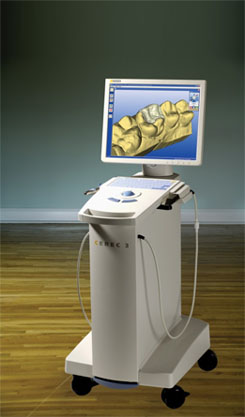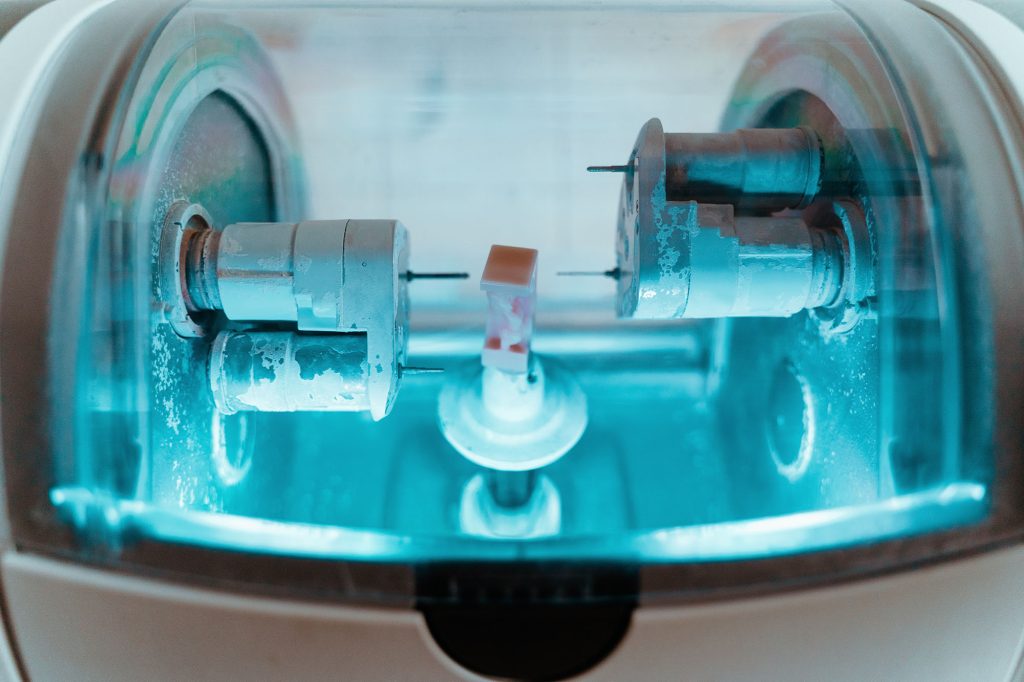- 406.549.5861
- Mon-Thurs: 8 AM–5 PM | Fri: 8 AM–12 PM
Home / Cerec
Save time on getting a tooth crown. Unlike traditional crowns, CEREC crowns can be done in just one visit!
Let’s face it very few of us have perfect teeth, free of decay and fillings. You can probably see a filling or two in your own mouth, which do just that — “fill” a cavity, or hole, in your tooth left from the excavation of decayed tooth structure. In many cases, those fillings are made of metal material and can go bad, weaken the tooth, or get additional decay under or around it. In fact, 1.2 billion of these metal fillings will need to be replaced in the next 10 years.
CEREC® is a method used by thousands of dentists worldwide since 1987 not only to replace these fillings, but also to restore any tooth that is decayed, weakened, broken, etc. to its natural strength and beauty. Better yet, it’s done with all-ceramic materials that are tooth colored in a single appointment!


Then, your Dentist takes an Optical Impression of the prepared tooth. Instead of filling a tray with impression “goop” that you must bite into and hold in your mouth until it hardens, your Dentist coats the tooth with a non-toxic, tasteless powder. A camera is then used to take a digital picture of your tooth. This whole Optical Impression process only takes a minute or two.
Next, the CEREC® machine helps the Dentist create the restoration for your tooth. The CEREC® 3D software takes the digital picture and converts it into a 3-dimensional virtual model on the computer screen. Your Dentist then uses his or her dental expertise to design the restoration using the CEREC® 3D computer program. Within a few minutes, your Dentist clicks a button, and the restoration design data is sent to a separate milling machine in the office. A ceramic block that matches your tooth shade is placed in the milling machine. About 10 – 20 minutes later, your all-ceramic, tooth-colored restoration is finished and ready to bond in place. Finally, your Dentist tries the restoration in your mouth to ensure proper fit and bite. The restoration is then polished and bonded to the prepared tooth. Your tooth is restored with no “temporary” or return trip necessary. All of this is done in a single appointment! Ask us about CEREC® today.

For an advanced dental restorative system that allows your dentist to restore decayed teeth, place crowns, remove defective amalgam fillings, or place cosmetic veneers in just one appointment. This allows you to have the highest quality, most lifelike dental restorations in just one visit to the dentist…in, out, and on with your busy life.
The CEREC® Acquisition Unit is mobile and houses a medical grade computer and the CEREC® camera. Your dentist uses the camera to take a digital picture of your prepared tooth. This picture is used instead of a traditional impression. This means no impression tray and material for you to gag on. The computer and CEREC® 3D software converts the digital picture to a three dimensional virtual model of your prepped tooth. Your dentist then designs your restoration right on screen using the software while you wait (and watch!). This software can assist your dentist with designing any single tooth restoration: crowns, inlays (fillings), onlays (partial crowns), and veneers. Once your dentist has designed your restoration (usually about 5 minutes), he or she clicks a button, and the design data is communicated via a wireless radio signal to the CEREC® Milling Unit.

Your dentist or dental assistant selects a ceramic block that matches the shade of the tooth being repaired. He or she then inserts the block into the Milling Unit. The data from the Acquisition Unit is used to direct two diamond coated burs to carve the block into the indicated shape of the restoration. This process usually takes 8 to 18 minutes depending on the size and type of restoration. After the milling is finished, your dentist polishes the finished filling or crown and bonds it into place.
CEREC® is a registered trademark of Sirona Dental Systems
If you’re considering getting a tooth crown, you may be wondering how much a CEREC crown costs compared to a traditional dental crown. The cost of a CEREC crown can vary depending on a variety of factors, including your location, the materials used, and the complexity of the procedure. However, in general, CEREC crowns tend to be more expensive than traditional dental crowns.
Here are some factors that can affect the cost of a CEREC crown:
Location: The cost of dental procedures can vary depending on where you live. In some areas, CEREC technology may be more readily available and therefore more affordable. In other areas, it may be less common and therefore more expensive.
Materials used: CEREC crowns are typically made of high-quality dental ceramic material, which can be more expensive than the materials used for traditional dental crowns. However, the durability and longevity of CEREC crowns may make them a more cost-effective option in the long run.
Complexity of the procedure: If your tooth requires a more complex restoration, such as a root canal or other additional treatment, the cost of a CEREC crown may be higher.
Overall, the cost of a CEREC crown can range from $800 to $2,000 or more, depending on the factors listed above. While this may seem expensive compared to traditional dental crowns, it’s important to consider the benefits of CEREC technology, such as convenience and accuracy, when weighing the cost.
If you’re interested in getting a CEREC crown, it’s a good idea to talk to your dentist about the cost and whether it’s covered by your dental insurance. Many dental insurance plans do cover CEREC crowns, so be sure to check with your provider to see what your coverage includes.
In addition, it’s important to consider the quality of the dental crown material used in the procedure. CEREC crowns are typically made of dental ceramic material, which is known for its durability and natural appearance. However, there are other materials used for traditional dental crowns, such as metal or porcelain-fused-to-metal, which may be more affordable but may not look as natural. Ultimately, the choice of dental crown material will depend on your individual needs and preferences.
CEREC technology offers numerous benefits, but there are also potential drawbacks to consider before choosing this option for your dental crown. Here are a few disadvantages of CEREC:
High upfront cost: CEREC crowns can be more expensive than traditional crowns, largely due to the high cost of the equipment needed to create them.
It’s important to note, however, that these drawbacks may not be significant enough to outweigh the benefits of CEREC, depending on your individual needs and preferences.
When considering the disadvantages of CEREC, it’s also important to weigh them against the potential drawbacks of traditional dental crowns, such as:
Longer turnaround time: Traditional crowns often require multiple appointments and a longer wait time while the crown is fabricated at a dental lab.
Risk of human error: With traditional dental crowns, there is always the possibility of human error during the crafting process, which can affect the fit and durability of the crown.
Overall, the disadvantages of CEREC may be minimal in comparison to the benefits it offers, such as convenience and accuracy.
When it comes to getting a dental crown, there are two main approaches: the traditional method and the CEREC method. Here’s a closer look at how the two differ:
Traditional crown procedure: The traditional method of getting a dental crown involves taking impressions of the tooth and sending them to a lab to create a customized crown. This process can take several weeks, during which time the patient wears a temporary crown. Once the permanent crown is ready, the patient returns to the dentist’s office to have it installed. Read more about traditional crowns here.
CEREC procedure: CEREC technology allows dentists to create a custom crown in the office, using 3D imaging and a milling machine. This process can often be completed in a single visit, which is a major advantage for patients who don’t want to make multiple trips to the dentist. Additionally, CEREC crowns are often more precise and accurate than traditional crowns.
As with any dental procedure, the cost of CEREC can be a significant factor in deciding whether or not it is worth it. However, there are several benefits to consider when evaluating the value of CEREC:
It’s important to consult with your dentist to determine if CEREC is the right choice for you, taking into account your individual needs and budget.
When searching for a dentist to perform CEREC procedures, it’s important to find a qualified provider. To learn more about Discovery Dental and the dental services we provide, visit our services page.
CEREC technology has been around for over three decades, and its popularity has grown steadily among dental professionals over the years. According to a survey conducted by the American Dental Association, in 2019, about 17% of all dentists in the US reported using CAD/CAM technology like CEREC to produce dental restorations. This percentage is expected to continue to rise in the coming years as more dentists adopt this technology.
In Missoula, there are several dental clinics and practices that offer CEREC technology to their patients. If you are looking for a Missoula dentist who uses CEREC, it’s important to do your research and ask questions about their experience and qualifications with this technology. Choosing a dentist who is knowledgeable and experienced with CEREC can help ensure that you receive the best possible care and outcomes for your dental needs.
CEREC technology is often more expensive than traditional dental crowns due to several factors. Here are some reasons why:
Despite the higher upfront cost of CEREC, it is important to consider the long-term benefits of the technology. CEREC restorations can last for many years with proper care, which can save patients money in the long run by reducing the need for future dental work. Additionally, the convenience and accuracy of CEREC technology can be worth the extra cost for many patients.
© 2023 Discovery Dental. All Rights Reserved.
© 2023 Discovery Dental.
All Rights Reserved.